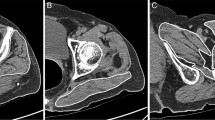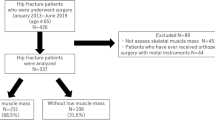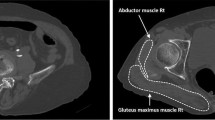Abstract
Hip muscles play an increasingly important role in lower limb function with aging. Investigating the deterioration of hip muscles and its relationship with hip fracture (HF) may help identify older adults prone to fall. In this study, patients with fall-related HF within 48 h and non-fracture controls aged ≥ 60 years were enrolled. The cross-sectional area (size) and attenuation (density) of the hip flexors, extensors, adductors, and abductors were calculated after segmentation on computed tomography images. The correlation of muscle parameters with HF and age were evaluated using logistic and multiple regression, respectively. Discrimination of HF was analyzed by receiver-operating characteristic analyses. A total of 220 patients and 91 controls were included. The size of the flexors, extensors, and abductors, and the density of the flexors, adductors, and abductors were lower in patients with HF after adjustment for sex, age, and body mass index (BMI). However, decreased muscle size was only observed in hip extensors in patients aged 60–74 years. Decreased muscle size was associated with HF independent of sex, age, BMI, and hip trabecular bone mineral density. Abductor size exhibited a significantly larger negative correlation with age in patients compared to controls. Including abductor size or all muscle size was effective for discrimination of HF in patients aged ≥ 75 years. In conclusion, older adults with HF may have sustained extensive and differential hip muscle deterioration before the injury; extensor atrophy in younger-old age and consideration of a closer relationship between abductor size and age deserve attention.



Similar content being viewed by others
References
Lewiecki EM, Wright NC, Curtis JR, Siris E, Gagel RF, Saag KG, Singer AJ, Steven PM, Adler RA (2018) Hip fracture trends in the United States, 2002 to 2015. Osteoporos Int 29:717–722. https://doi.org/10.1007/s00198-017-4345-0
Zhang C, Feng J, Wang S, Gao P, Xu L, Zhu J, Jia J, Liu L, Liu G, Wang J, Zhan S, Song C (2020) Incidence of and trends in hip fracture among adults in urban China: a nationwide retrospective cohort study. PLoS Med 17:e1003180. https://doi.org/10.1371/journal.pmed.1003180
Brauer CA, Coca-Perraillon M, Cutler DM, Rosen AB (2009) Incidence and mortality of hip fractures in the United States. JAMA 302:1573–1579. https://doi.org/10.1001/jama.2009.1462
Jantzen C, Madsen CM, Lauritzen JB, Jorgensen HL (2018) Temporal trends in hip fracture incidence, mortality, and morbidity in Denmark from 1999 to 2012. Acta Orthop 89:170–176. https://doi.org/10.1080/17453674.2018.1428436
Dyer SM, Crotty M, Fairhall N, Magaziner J, Beaupre LA, Cameron ID, Sherrington C, Fragility fracture network rehabilitation research special interest G (2016) A critical review of the long-term disability outcomes following hip fracture. BMC Geriatr 16:158. https://doi.org/10.1186/s12877-016-0332-0
Aarden JJ, van der Esch M, Engelbert RHH, van der Schaaf M, de Rooij SE, Buurman BM (2017) Hip fractures in older patients: trajectories of disability after surgery. J Nutr Health Aging 21:837–842. https://doi.org/10.1007/s12603-016-0830-y
Berry SD, Daiello LA, Lee Y, Zullo AR, Wright NC, Curtis JR, Kiel DP (2020) Secular trends in the incidence of hip fracture among nursing home residents. J Bone Miner Res 35:1668–1675. https://doi.org/10.1002/jbmr.4032
Larsson L, Degens H, Li M, Salviati L, Lee YI, Thompson W, Kirkland JL, Sandri M (2019) Sarcopenia: aging-related loss of muscle mass and function. Physiol Rev 99:427–511. https://doi.org/10.1152/physrev.00061.2017
Kulmala JP, Korhonen MT, Kuitunen S, Suominen H, Heinonen A, Mikkola A, Avela J (2014) Which muscles compromise human locomotor performance with age? J R Soc Interface 11:20140858. https://doi.org/10.1098/rsif.2014.0858
Spinoso DH, Marques NR, LaRoche DP, Hallal CZ, Karuka AH, Milanezi FC, Goncalves M (2019) Hip, knee, and ankle functional demand during habitual and fast-pace walking in younger and older women. J Aging Phys Act 27:242–251. https://doi.org/10.1123/japa.2017-0351
Franz JR, Kram R (2013) How does age affect leg muscle activity/coactivity during uphill and downhill walking? Gait Posture 37:378–384. https://doi.org/10.1016/j.gaitpost.2012.08.004
Lang T, Koyama A, Li C, Li J, Lu Y, Saeed I, Gazze E, Keyak J, Harris T, Cheng X (2008) Pelvic body composition measurements by quantitative computed tomography: association with recent hip fracture. Bone 42:798–805. https://doi.org/10.1016/j.bone.2007.12.002
Wang L, Yin L, Zhao Y, Su Y, Sun W, Liu Y, Yang M, Yu A, Blake GM, Cheng X, Wu X, Veldhuis A, Engelke K (2020) Muscle density discriminates hip fracture better than computed tomography X-ray absorptiometry hip areal bone mineral density. J Cachexia Sarcopenia Muscle 11:1799–1812. https://doi.org/10.1002/jcsm.12616
Erinc S, Bozca MA, Bankaoglu M, Cakirturk S, Yahsi Y, Ozdemir HM (2020) Association of abductor hip muscle atrophy with fall-related proximal femur fractures in the elderly. Injury 51:1626–1633. https://doi.org/10.1016/j.injury.2020.04.054
Turkmen I, Ozcan C (2019) Osteosarcopenia increases hip fracture risk: a case-controlled study in the elderly. J Back Musculoskelet Rehabil 32:613–618. https://doi.org/10.3233/BMR-181389
Cruz-Jentoft AJ, Bahat G, Bauer J, Boirie Y, Bruyere O, Cederholm T, Cooper C, Landi F, Rolland Y, Sayer AA, Schneider SM, Sieber CC, Topinkova E, Vandewoude M, Visser M, Zamboni M (2019) Sarcopenia: revised European consensus on definition and diagnosis. Age Ageing 48:16–31. https://doi.org/10.1093/ageing/afy169
Lenchik L, Lenoir KM, Tan J, Boutin RD, Callahan KE, Kritchevsky SB, Wells BJ (2019) Opportunistic measurement of skeletal muscle size and muscle attenuation on computed tomography predicts 1-year mortality in medicare patients. J Gerontol A Biol Sci Med Sci 74:1063–1069. https://doi.org/10.1093/gerona/gly183
Lang TF, Keyak JH, Heitz MW, Augat P, Lu Y, Mathur A, Genant HK (1997) Volumetric quantitative computed tomography of the proximal femur: precision and relation to bone strength. Bone 21:101–108. https://doi.org/10.1016/s8756-3282(97)00072-0
Ling M, Li X, Xu Y, Fan Y (2021) Spatial distribution of hip cortical thickness in postmenopausal women with different osteoporotic fractures. Arch Osteoporos 16:172. https://doi.org/10.1007/s11657-021-01039-9
Cruz-Jentoft AJ, Baeyens JP, Bauer JM, Boirie Y, Cederholm T, Landi F, Martin FC, Michel JP, Rolland Y, Schneider SM, Topinkova E, Vandewoude M, Zamboni M, European working group on Sarcopenia in older P (2010) Sarcopenia: European consensus on definition and diagnosis: report of the European working group on Sarcopenia in older people. Age Ageing 39:412–423. https://doi.org/10.1093/ageing/afq034
Wilburn D, Ismaeel A, Machek S, Fletcher E, Koutakis P (2021) Shared and distinct mechanisms of skeletal muscle atrophy: a narrative review. Ageing Res Rev 71:101463. https://doi.org/10.1016/j.arr.2021.101463
DeVita P (1985) Hortobagyi T (2000) Age causes a redistribution of joint torques and powers during gait. J Appl Physiol 88:1804–1811. https://doi.org/10.1152/jappl.2000.88.5.1804
Daguet E, Jolivet E, Bousson V, Boutron C, Dahmen N, Bergot C, Vicaut E, Laredo JD (2011) Fat content of hip muscles: an anteroposterior gradient. J Bone Joint Surg Am 93:1897–1905. https://doi.org/10.2106/JBJS.J.00509
Miokovic T, Armbrecht G, Felsenberg D (1985) Belavy DL (2011) Differential atrophy of the postero-lateral hip musculature during prolonged bedrest and the influence of exercise countermeasures. J Appl Physiol 110:926–934. https://doi.org/10.1152/japplphysiol.01105.2010
Dilani Mendis M, Hides JA, Wilson SJ, Grimaldi A, Belavy DL, Stanton W, Felsenberg D, Rittweger J, Richardson C (2009) Effect of prolonged bed rest on the anterior hip muscles. Gait Posture 30:533–537. https://doi.org/10.1016/j.gaitpost.2009.08.002
Miokovic T, Armbrecht G, Felsenberg D (1985) Belavy DL (2012) heterogeneous atrophy occurs within individual lower limb muscles during 60 days of bed rest. J Appl Physiol 113:1545–1559. https://doi.org/10.1152/japplphysiol.00611.2012
Gafner SC, Bastiaenen CHG, Ferrari S, Gold G, Trombetti A, Terrier P, Hilfiker R, Allet L (2020) The role of hip abductor strength in identifying older persons at risk of falls: a diagnostic accuracy study. Clin Interv Aging 15:645–654. https://doi.org/10.2147/CIA.S246998
Addison O, Inacio M, Bair WN, Beamer BA, Ryan AS, Rogers MW (2017) Role of hip abductor muscle composition and torque in protective stepping for lateral balance recovery in older adults. Arch Phys Med Rehabil 98:1223–1228. https://doi.org/10.1016/j.apmr.2016.10.009
Milde S, Adalbert R, Elaman MH, Coleman MP (2015) Axonal transport declines with age in two distinct phases separated by a period of relative stability. Neurobiol Aging 36:971–981. https://doi.org/10.1016/j.neurobiolaging.2014.09.018
Hu P, Bembrick AL, Keay KA, McLachlan EM (2007) Immune cell involvement in dorsal root ganglia and spinal cord after chronic constriction or transection of the rat sciatic nerve. Brain Behav Immun 21:599–616. https://doi.org/10.1016/j.bbi.2006.10.013
Wust RC, Gibbings SL, Degens H (2009) Fiber capillary supply related to fiber size and oxidative capacity in human and rat skeletal muscle. Adv Exp Med Biol 645:75–80. https://doi.org/10.1007/978-0-387-85998-9_12
Gao Y, Arfat Y, Wang H, Goswami N (2018) Muscle atrophy induced by mechanical unloading: mechanisms and potential countermeasures. Front Physiol 9:235. https://doi.org/10.3389/fphys.2018.00235
Winter DA (1995) Human balance and posture control during standing and walking. Gait Posture 3:193–214. https://doi.org/10.1016/0966-6362(96)82849-9
Vistamehr A, Neptune RR (2021) Differences in balance control between healthy younger and older adults during steady-state walking. J Biomech 128:110717. https://doi.org/10.1016/j.jbiomech.2021.110717
Bruijn SM, van Dieen JH (2018) Control of human gait stability through foot placement. J R Soc Interface. https://doi.org/10.1098/rsif.2017.0816
Rankin BL, Buffo SK, Dean JC (2014) A neuromechanical strategy for mediolateral foot placement in walking humans. J Neurophysiol 112:374–383. https://doi.org/10.1152/jn.00138.2014
Neptune RR, McGowan CP (2016) Muscle contributions to frontal plane angular momentum during walking. J Biomech 49:2975–2981. https://doi.org/10.1016/j.jbiomech.2016.07.016
Bhasin S, Gill TM, Reuben DB, Latham NK, Ganz DA, Greene EJ, Dziura J, Basaria S, Gurwitz JH, Dykes PC, McMahon S, Storer TW, Gazarian P, Miller ME, Travison TG, Esserman D, Carnie MB, Goehring L, Fagan M, Greenspan SL, Alexander N, Wiggins J, Ko F, Siu AL, Volpi E, Wu AW, Rich J, Waring SC, Wallace RB, Casteel C, Resnick NM, Magaziner J, Charpentier P, Lu C, Araujo K, Rajeevan H, Meng C, Allore H, Brawley BF, Eder R, McGloin JM, Skokos EA, Duncan PW, Baker D, Boult C, Correa-de-Araujo R, Peduzzi P (2020) A randomized trial of a multifactorial strategy to prevent serious fall injuries. N Engl J Med 383:129–140. https://doi.org/10.1056/NEJMoa2002183
Funding
This study was funded by National Key R&D Program of China (Grant No. 2020YFC2008700), Shanghai Clinical Research Center for Rehabilitation Medicine (Grant No. 21MC1930200), Science and Technology Commission of Shanghai Municipality (Grant No. 15411951500), and Foundation of Shanghai Municipal Commission of Health and Family Planning (Grant No. 2015ZB0501).
Author information
Authors and Affiliations
Contributions
ML and HH were responsible for data analysis, data interpretation, and manuscript preparation; and XL and YX for data acquisition and preprocessing; and YF for study design and manuscript revision.
Corresponding author
Ethics declarations
Conflict of interest
Ming Ling, Hou Huang, Xianlong Li, Yueyang Xu, and Yongqian Fan have no competing interests to declare that are relevant to the content of this article.
Ethical Approval
The study was approved by Ethical Committee of Huadong Hospital Affiliated to Fudan University. All procedures performed in studies involving human participants were in accordance with the ethical standards of the institutional and/or national research committee and with the 1964 Helsinki declaration and its later amendments or comparable ethical standards.
Informed consent
Informed consent was obtained from all individual participants included in the study.
Additional information
Publisher's Note
Springer Nature remains neutral with regard to jurisdictional claims in published maps and institutional affiliations.
Supplementary Information
Below is the link to the electronic supplementary material.
Rights and permissions
Springer Nature or its licensor (e.g. a society or other partner) holds exclusive rights to this article under a publishing agreement with the author(s) or other rightsholder(s); author self-archiving of the accepted manuscript version of this article is solely governed by the terms of such publishing agreement and applicable law.
About this article
Cite this article
Ling, M., Huang, H., Li, X. et al. Extensive and Differential Deterioration of Hip Muscles May Preexist in Older Adults with Hip Fractures: Evidence from a Cross-Sectional Study. Calcif Tissue Int 112, 328–337 (2023). https://doi.org/10.1007/s00223-022-01043-2
Received:
Accepted:
Published:
Issue Date:
DOI: https://doi.org/10.1007/s00223-022-01043-2




